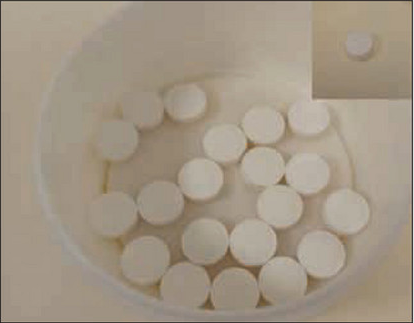Developing and evaluation of orodispersible tablets containing caffeine

Starting from the premise that a reduced number of active pharmaceutical ingredients (APIs) are used to treat hypotension, the aim of this study consisted of developing new formulations of caffeine-orodispersible tablets (CAF- ODTs). The formulation variables were the type of disintegrant and its concentration. The CAF-ODTs were prepared by direct compression, (CAF1, CAF2 and, CAF3) each of them containing 100 mg of CAF / tablet. The proposed formulations were analyzed from a pharmacotechnical point of view. For the formulations developed the tablets’ physical appearance, resistance to crushing, friability, disintegration behaviour, and the in vitro caffeine release were evaluated. White tablets, with a resistance to crushing decreasing in the following order CAF1 > CAF2 > CAF3 were obtained. The friability test showed that all the formulations are respecting the in-force European Pharmacopoeia (Ph. Eur. 10) requirements with values less than 1 %.
The disintegration time for all three formulations was less than 180 seconds, the smallest time being registered in the case of CAF2 formulation, where Sodium Starch Glycolate (SSG) was used as a disintegrant (24-30 s, as a result of the different methods used. Through the in vitro releasing study, it was observed that over 99.9 % caffeine was released from all three analyzed formulations. By investigating the amount of caffeine released after 1 minute, it can be noticed that the largest amount released was recorded in CAF2 formulations, where SSG was used as a disintegrant. Compared to CAF2, the amount of CAF released was reduced to half, after the first five minutes for CAF1 formulation, where sodium croscarmellose was used, and ten times lower in the case of CAF3 where no disintegrant was used. Based on the results obtained we can conclude that all three formulations are respecting the pharmacotechnical in-force officinal requirements. The presence of SSG in the CAF2 formulation led to obtaining tablets with a reduced disintegration time in comparison to the other two formulations proposed in this study.
Download the full article here: Developing and evaluation of orodispersible tablets containing caffeine
More on CMC and Croscarmellose Sodium
Article Information: Ro J Pharm Pract. 2021;14(1) DOI: 10.37897/RJPhP.2021.1.5 by Assist. Prof. Robert-Alexandru Vlad, Elena-Beatrice Trifan, Lecturer Paula Antonoaea, Lecturer Emőke-Margit Rédai, Lecturer Béla Kovács, Assoc. Prof. Nicoleta Todoran, Anamaria Tătaru, Prof. Adriana Ciurb
Developing orodispersible tablets with caffeine – Materials and Methods
To obtain orodispersible tablets the following pharmaceutical ingredients were used: API – caffeine – (CAF – Rochem, United States of America – USA), lactose, Lactopress® (LCT – DFE Pharma, Germany), sodium croscarmellose, Vivasol®CCS – JRS Pharma, Austria), sodium starch glycolate, Primojel® (SSG – DFE Pharma, Germany), Aerosil® 200 (Degussa, Japan), Magnesium stearate (Alfa Aesar, USA), mannitol, (MNT – VWR Chemicals, USA) and banana flavour (BFL – JinTai, China). The proposed formulations were obtained using an eccentric press (Korsch, Germany), using 10 mm punches. The powders were mixed using a V Blender (YM-4, United Kingdom) in reverse order of their densities, the last powders added being the lubricants. Three formulations of caffeine orodispersible tablets (CAF-ODTs) were produced noted as CAF1, CAF2 and, CAF3, their composition is presented in Table 1.

